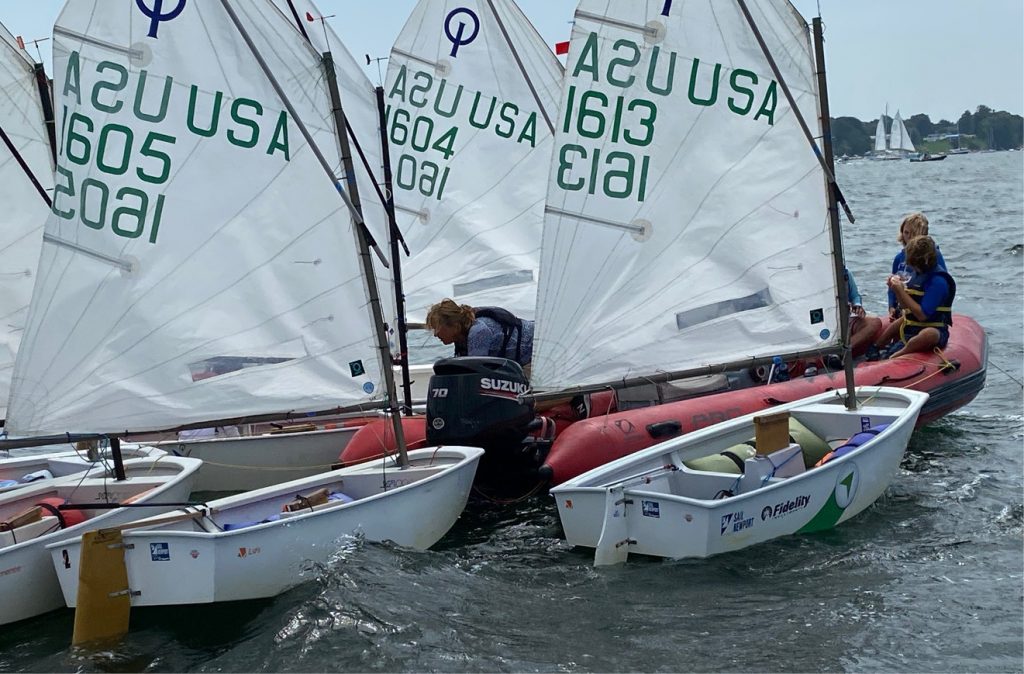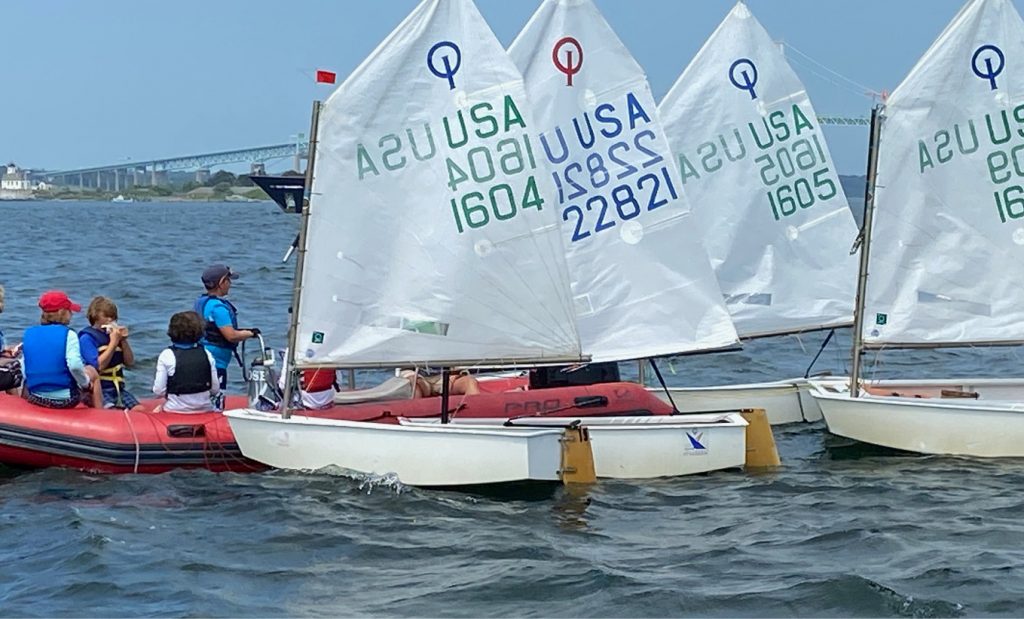Regular readers will know of my penchant for using metaphors from Star Wars. Today’s line is “You need not be a Jedi to see into the future.” I cannot be the only sailor doing some head scratching about the results of the U.S. Olympic Sailing Team in Japan. I do not envy Paul Cayard’s new job as the director of this team. I would recommend, Paul, you get out and do as I have just done and work an Opti regatta. Full disclosure: I’m not a particular fan of the boat, but there are a lot of them and anything that gets kids on the water in something with a sail, well that’s OK by me.
The regatta in question was the Opti New England Championships, hosted by Sail Newport over three days in early August. Anyone driving over the hill into Fort Adams and setting eyes on the multitude of boats on the grass would not credit there is a declination in sailing. THAT is just for the grown-ups. There were I guess half a dozen “lanes” marked off with stakes and lines to bring some order to 170 Padawans. And their parents, coaches, and related supporters.
The regatta was divided into two fleets, the Championship fleet, combining I guess the usual colors into one massive fleet, though I’m not certain because I was with the Nippers in the Green fleet. This is the low-key fleet for the Padawan Learners and had 20 entries. Now, maybe Green fleet is not where the top gun kids sail (though I’m certain all the sailors in the championship circles have passed through); rather it’s where the skill set range starts at “can more or less sail” but not really tuned to racing, all the way to those kids demonstrably skilled, and sort of up to speed with racing. The single biggest area where these kids need help is, no surprise, the Racing Rules, particularly port and starboard and mark roundings. It is a good thing that Optis are small, light, don’t go fast and are pretty rugged little boats.


But as sailing administrators are finally realizing, racing is not the only skill kids can and need to develop. They also need some sense of seamanship. Like this episode: I was standing by on the course when I realized I had left a fender over the side. I was in the process of untying it when I dropped it. I hailed one of the nearby kids, pointed at the fender and asked if he could pick it up. He was 20-30 feet away, but immediately saw the situation. He tacked, bore off enough to get below, downwind of the bearing to the fender, eased his main significantly, idled up to the fender, scooped it up and dropped it in his boat. As neat a piece of boat handling and time/distance calculation as you could wish for. He then gybed, went far enough away to tack, and idled by my leeward side and held it up for me to take. But for my original call to him, no words were exchanged. I wish I’d recorded his sail number, but he was part of the Annapolis YC contingent.
The Roll Tack is the baseline return of sailing. You cannot practice it enough. It seems the roll tack drill today for Opti skippers is to tack the boat, stay on the leeward side, generating significant heel, then almost leap across to the weather side, thereby levering the boat back upright. This was a skill that I saw none of the kids fail at.
The first start of the first day might just as easily been a start at the Finn Gold Cup. No one was going to get left behind. It was a general recall in no uncertain terms. The second attempt must’ve been a general recall too, because at the recommendation of one of the veteran Opti coaches the coach boats formed up to weather of the starting line, in an attempt to keep the miscreants behind the line. This worked and we were off.
This success at actually getting a race off was tempered by the, how shall I say, unfamiliarity of the RRS, particularly the port/starboard sections. After the full fleet skippers meeting, there was a breakout meeting for the Green fleet conducted by PRO Nick Ewenson, Race Programs Director at Sail Newport.
The gist of the meeting was, “We are here for you to have fun and get better.” To this end, coaches were allowed – encouraged in fact – to actively help their charges during races. There were some sore throats driving home that night, I reckon.
The second admonition was to do your turn if you foul another competitor. On the course in practice, many did. There was a correlation between their skill in the boat, and knowledge of the rules, but like the man said, this was a learning regatta.
The sailing savvy and positional smarts (Course Management is I think the phrase in use today) of the top kids was impressive. Reading shifts pretty well, or so it looked to me, knowing where the current was and was not, and being mindful of where the guys behind you were. This latter aspect more readily displayed in the short beat from the leeward mark to the finish. The courses were mainly windward/leeward, with the bottom mark below the signal boat that was the start/finish line.
Another interesting detail was watching the kids go around marks. Again, the top kids were pretty good at getting around the corners. More than once I thought, “This kid is in the wrong fleet.” Mostly the laylines were sound, despite a strong flood current impacting the weather mark, and more than a couple of kids had the “roll to weather to minimize rudder use” technique down pat. On a couple occasions, I saw a boat lead around a top mark with a bandit hot on his rudder. The trailing boat attempted to reach up over the leader, who was having none of it, and immediately reached up to protect his lead…HIS being the operative word. By eyeball and reviewing the results, there were only two girls in the Green fleet, with Molly Kern from St. Francis YC finishing fourth. The other girl sailed only the first day.
There were two sailors who were pretty regularly in the back of the fleet. In the last race on the second day, Alden Durrell, also from Annapolis, had capsized just before the bottom mark, as had another kid. I was down in the area waiting to pick up the leeward mark. I was idling near the Annapolis coach boat when the coach called over and said he, Alden, wanted to finish the race. The other kid’s coach said the same. “Great,” said I, “Let ‘em loose.” We had already discussed in the breakout meeting that we might finish kids in place in order to keep the races rolling. But here were two kids, last in the last race of the day. Very easy to say, “Screw it” and get towed home. Not these two kids. Alden seemed to be taking out his frustration at capsizing by bailing like a demon, as was the other kid. They both finished bailing and struck out for the finish and did in fact complete the course. Last and second to last. Nick and I both gave them a hearty congratulations, to which they both responded with 1500-watt smiles.
Then even if drive and determination is not easy to measure, one might argue that Alden and his last place mate might be well worth nurturing, coz they were in the back of the bus all regatta and in the episode noted above could have easily chucked it in and been towed home. That kind of determination in Padawan Learners must account for something
I cannot be the only sailor who, when looking at other sailors, particularly when racing, thinks, “Boy, those guys are pretty good” all the way down to “Why are they bothering?” The quantitative measure of successful sailors is difficult to calibrate, relying mainly I guess on results. Demonstrably, Gil Hackel is skilled. He placed second in the 2021 Opti Worlds in Italy in June. One does not place second in a 200-boat fleet and not be capable. Paul – Get a hold of Gil and get him in a Laser, mate. Is that how an Olympic team is built? I dunno, but it’s one way to think about it.
Looking at the U.S. National Championships in July, three of the top ten finishers were kids from LISOT. Paul – Beat feet to Long Island Sound and find out what they’re doing. Or cut to the chase and find Richard Sykes, winner of the New England regatta and fourth in the Nationals. Or is a trip to Italy in order and see how they got three finishers in the top ten at the Worlds…?
My cursory reading of the Olympics today is that it is largely a circus, an increasingly expensive one, put on for professionals; at least the countries who feature at the top of the medal table send athletes who work in their respective games. I don’t recall when the Corinthian aspect of the Olympics vanished, but it was in place in the late 1970s when I was looking at trying to win a berth, in the Finn.
I just had a look at the overall medal tally by country. USA was on top with 113. Then there was a substantial jump to second, China with 88. And Russia third with 71. I read a caption on Buzzfeed about a Chinese competitor winning a gold medal in something called “10-Meter Air Rifle.” Congratulations to her. I find two things curious about this. That shooting an air rifle is an Olympic sport, and the pretty big disparity in total medal count and the equally large, if not gaping, chasm in the political systems of the top two or three countries. Speaking of gaping chasms, there’s a rabbit hole to avoid going down.
It is much better to go out and watch kids banging around in boats, bailing to beat the band so they can finish, all across three fantastic days of sailing in Newport under sunny skies and the right kinds of breezes, and all laughing. No need for Jedi skills there. ■
Australian born, Joe ‘Coop’ Cooper stayed in the U.S. after the 1980 America’s Cup where he was the boat captain and sailed as Grinder/Sewer-man on Australia. His whole career has focused on sailing, especially the short-handed aspects of it. He lives in Middletown, RI where he coaches, consults and writes on his blog, joecoopersailing.com, when not paying attention to his wife, dog and several, mainly small, boats.




